TPMS TESLA MODEL S 2015 クイックガイド (in Japanese)
[x] Cancel search | Manufacturer: TESLA, Model Year: 2015, Model line: MODEL S, Model: TESLA MODEL S 2015Pages: 96, PDF Size: 2.86 MB
Page 26 of 96
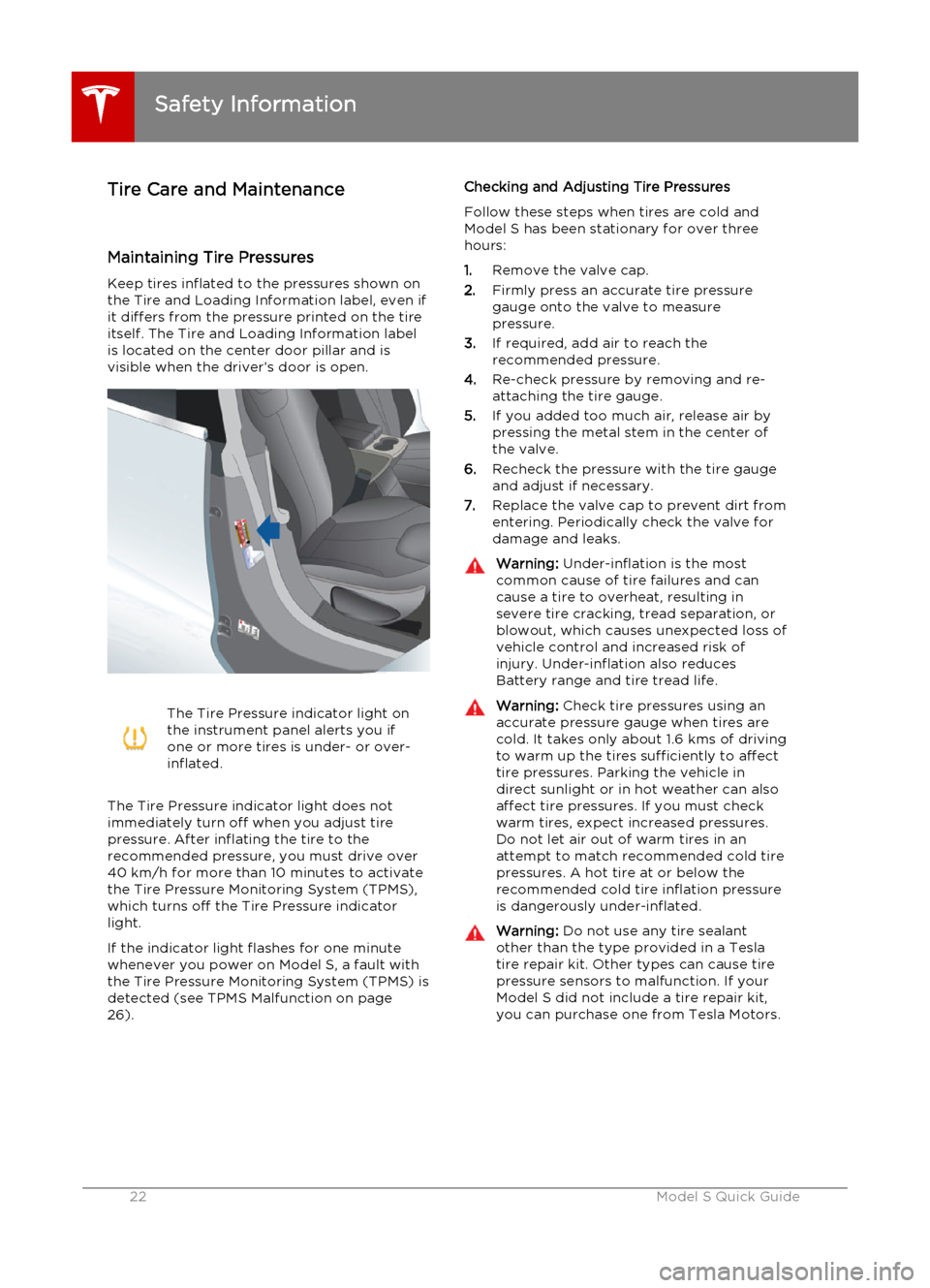
Tire Care and Maintenance
Maintaining Tire Pressures Keep tires inflated to the pressures shown on
the Tire and Loading Information label, even if it differs from the pressure printed on the tireitself. The Tire and Loading Information labelis located on the center door pillar and is
visible when the driver’s door is open.The Tire Pressure indicator light on
the instrument panel alerts you if
one or more tires is under- or over-
inflated.
The Tire Pressure indicator light does not
immediately turn off when you adjust tire
pressure. After inflating the tire to the
recommended pressure, you must drive over
40 km/h for more than 10 minutes to activate
the Tire Pressure Monitoring System (TPMS),
which turns off the Tire Pressure indicator
light.
If the indicator light flashes for one minute whenever you power on Model S, a fault with
the Tire Pressure Monitoring System (TPMS) is detected (see TPMS Malfunction on page
26).
Checking and Adjusting Tire Pressures
Follow these steps when tires are cold andModel S has been stationary for over three
hours:
1. Remove the valve cap.
2. Firmly press an accurate tire pressure
gauge onto the valve to measure
pressure.
3. If required, add air to reach the
recommended pressure.
4. Re-check pressure by removing and re-
attaching the tire gauge.
5. If you added too much air, release air by
pressing the metal stem in the center of
the valve.
6. Recheck the pressure with the tire gauge
and adjust if necessary.
7. Replace the valve cap to prevent dirt from
entering. Periodically check the valve for
damage and leaks.Warning: Under-inflation is the most
common cause of tire failures and can
cause a tire to overheat, resulting in
severe tire cracking, tread separation, or
blowout, which causes unexpected loss of vehicle control and increased risk ofinjury. Under-inflation also reduces
Battery range and tire tread life.Warning: Check tire pressures using an
accurate pressure gauge when tires are
cold. It takes only about 1.6 kms of driving
to warm up the tires sufficiently to affect
tire pressures. Parking the vehicle in
direct sunlight or in hot weather can also affect tire pressures. If you must checkwarm tires, expect increased pressures.Do not let air out of warm tires in an
attempt to match recommended cold tire
pressures. A hot tire at or below the
recommended cold tire inflation pressure
is dangerously under-inflated.Warning: Do not use any tire sealant
other than the type provided in a Tesla tire repair kit. Other types can cause tire
pressure sensors to malfunction. If your Model S did not include a tire repair kit,
you can purchase one from Tesla Motors.
Safety Information
22Model S Quick Guide
Page 28 of 96
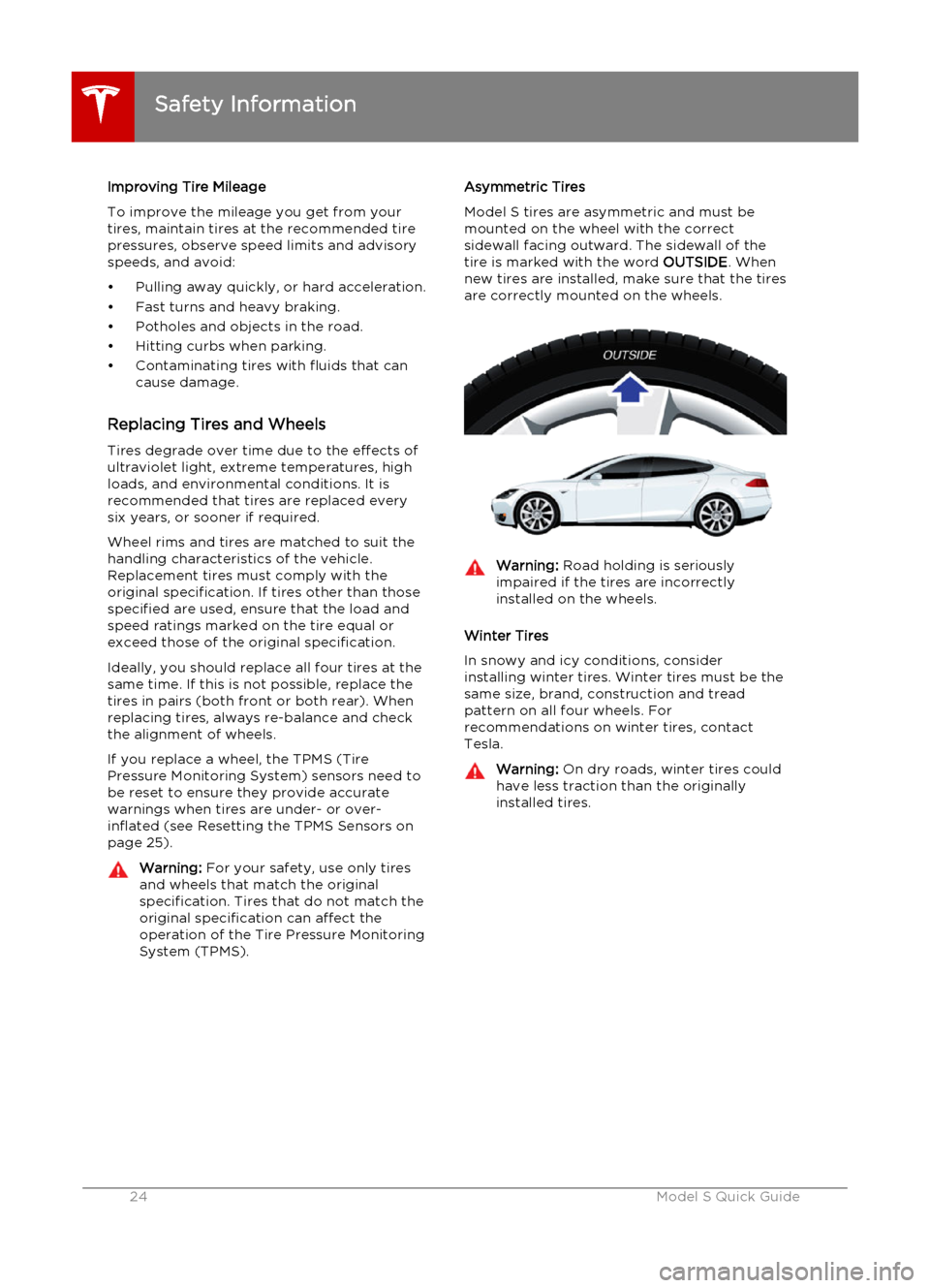
Improving Tire Mileage
To improve the mileage you get from your
tires, maintain tires at the recommended tire pressures, observe speed limits and advisory
speeds, and avoid:
• Pulling away quickly, or hard acceleration.
• Fast turns and heavy braking.
• Potholes and objects in the road.
• Hitting curbs when parking.
• Contaminating tires with fluids that can cause damage.
Replacing Tires and Wheels
Tires degrade over time due to the effects of
ultraviolet light, extreme temperatures, high loads, and environmental conditions. It is
recommended that tires are replaced every
six years, or sooner if required.
Wheel rims and tires are matched to suit the
handling characteristics of the vehicle.
Replacement tires must comply with the
original specification. If tires other than those
specified are used, ensure that the load and
speed ratings marked on the tire equal or
exceed those of the original specification.
Ideally, you should replace all four tires at the
same time. If this is not possible, replace the
tires in pairs (both front or both rear). When
replacing tires, always re-balance and check
the alignment of wheels.
If you replace a wheel, the TPMS (Tire
Pressure Monitoring System) sensors need to
be reset to ensure they provide accurate
warnings when tires are under- or over-
inflated (see Resetting the TPMS Sensors on
page 25).Warning: For your safety, use only tires
and wheels that match the original
specification. Tires that do not match the
original specification can affect the
operation of the Tire Pressure Monitoring System (TPMS).Asymmetric Tires
Model S tires are asymmetric and must be
mounted on the wheel with the correct sidewall facing outward. The sidewall of thetire is marked with the word OUTSIDE. When
new tires are installed, make sure that the tires
are correctly mounted on the wheels.Warning: Road holding is seriously
impaired if the tires are incorrectly
installed on the wheels.
Winter Tires
In snowy and icy conditions, consider installing winter tires. Winter tires must be the
same size, brand, construction and tread
pattern on all four wheels. For
recommendations on winter tires, contact Tesla.
Warning: On dry roads, winter tires could
have less traction than the originally
installed tires.
Safety Information
24Model S Quick Guide
Page 29 of 96
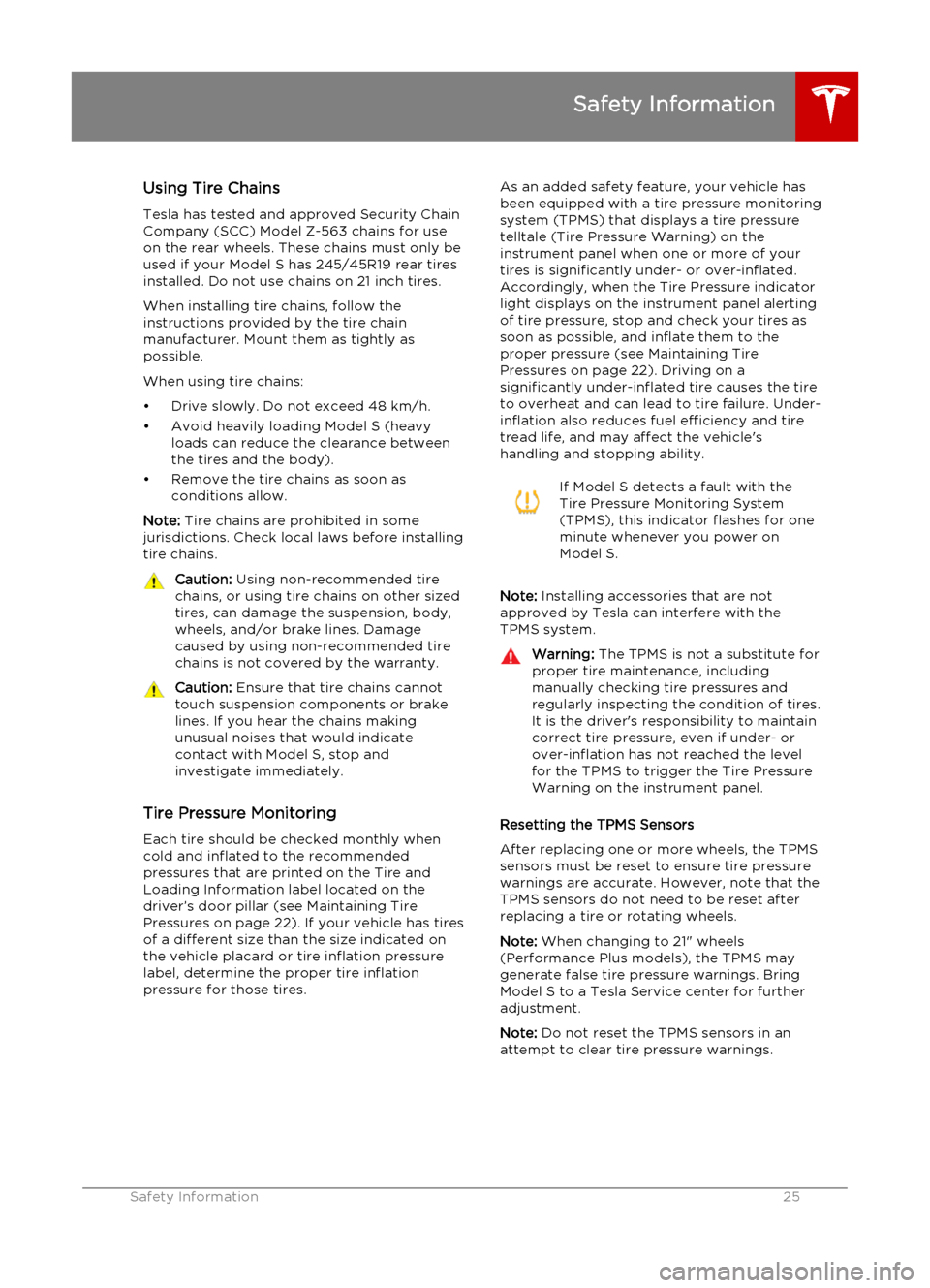
Using Tire ChainsTesla has tested and approved Security Chain
Company (SCC) Model Z-563 chains for use
on the rear wheels. These chains must only be
used if your Model S has 245/45R19 rear tires
installed. Do not use chains on 21 inch tires.
When installing tire chains, follow the
instructions provided by the tire chain
manufacturer. Mount them as tightly as
possible.
When using tire chains:
• Drive slowly. Do not exceed 48 km/h.
• Avoid heavily loading Model S (heavy loads can reduce the clearance betweenthe tires and the body).
• Remove the tire chains as soon as conditions allow.
Note: Tire chains are prohibited in some
jurisdictions. Check local laws before installing
tire chains.Caution: Using non-recommended tire
chains, or using tire chains on other sized tires, can damage the suspension, body,wheels, and/or brake lines. Damagecaused by using non-recommended tire
chains is not covered by the warranty.Caution: Ensure that tire chains cannot
touch suspension components or brake
lines. If you hear the chains making
unusual noises that would indicate
contact with Model S, stop and
investigate immediately.
Tire Pressure Monitoring
Each tire should be checked monthly when
cold and inflated to the recommended
pressures that are printed on the Tire and
Loading Information label located on the
driver’s door pillar (see Maintaining Tire Pressures on page 22). If your vehicle has tires
of a different size than the size indicated on
the vehicle placard or tire inflation pressure
label, determine the proper tire inflation
pressure for those tires.
As an added safety feature, your vehicle has
been equipped with a tire pressure monitoring system (TPMS) that displays a tire pressuretelltale (Tire Pressure Warning) on the
instrument panel when one or more of your
tires is significantly under- or over-inflated.
Accordingly, when the Tire Pressure indicator
light displays on the instrument panel alerting
of tire pressure, stop and check your tires as
soon as possible, and inflate them to the proper pressure (see Maintaining TirePressures on page 22). Driving on a
significantly under-inflated tire causes the tire
to overheat and can lead to tire failure. Under-
inflation also reduces fuel efficiency and tire
tread life, and may affect the vehicle's
handling and stopping ability.If Model S detects a fault with the
Tire Pressure Monitoring System
(TPMS), this indicator flashes for one
minute whenever you power on
Model S.
Note: Installing accessories that are not
approved by Tesla can interfere with the TPMS system.
Warning: The TPMS is not a substitute for
proper tire maintenance, including
manually checking tire pressures and
regularly inspecting the condition of tires.
It is the driver's responsibility to maintain
correct tire pressure, even if under- or
over-inflation has not reached the level
for the TPMS to trigger the Tire Pressure Warning on the instrument panel.
Resetting the TPMS Sensors
After replacing one or more wheels, the TPMS sensors must be reset to ensure tire pressurewarnings are accurate. However, note that theTPMS sensors do not need to be reset after
replacing a tire or rotating wheels.
Note: When changing to 21" wheels
(Performance Plus models), the TPMS may
generate false tire pressure warnings. Bring
Model S to a Tesla Service center for further
adjustment.
Note: Do not reset the TPMS sensors in an
attempt to clear tire pressure warnings.
Safety Information
Safety Information25
Page 30 of 96
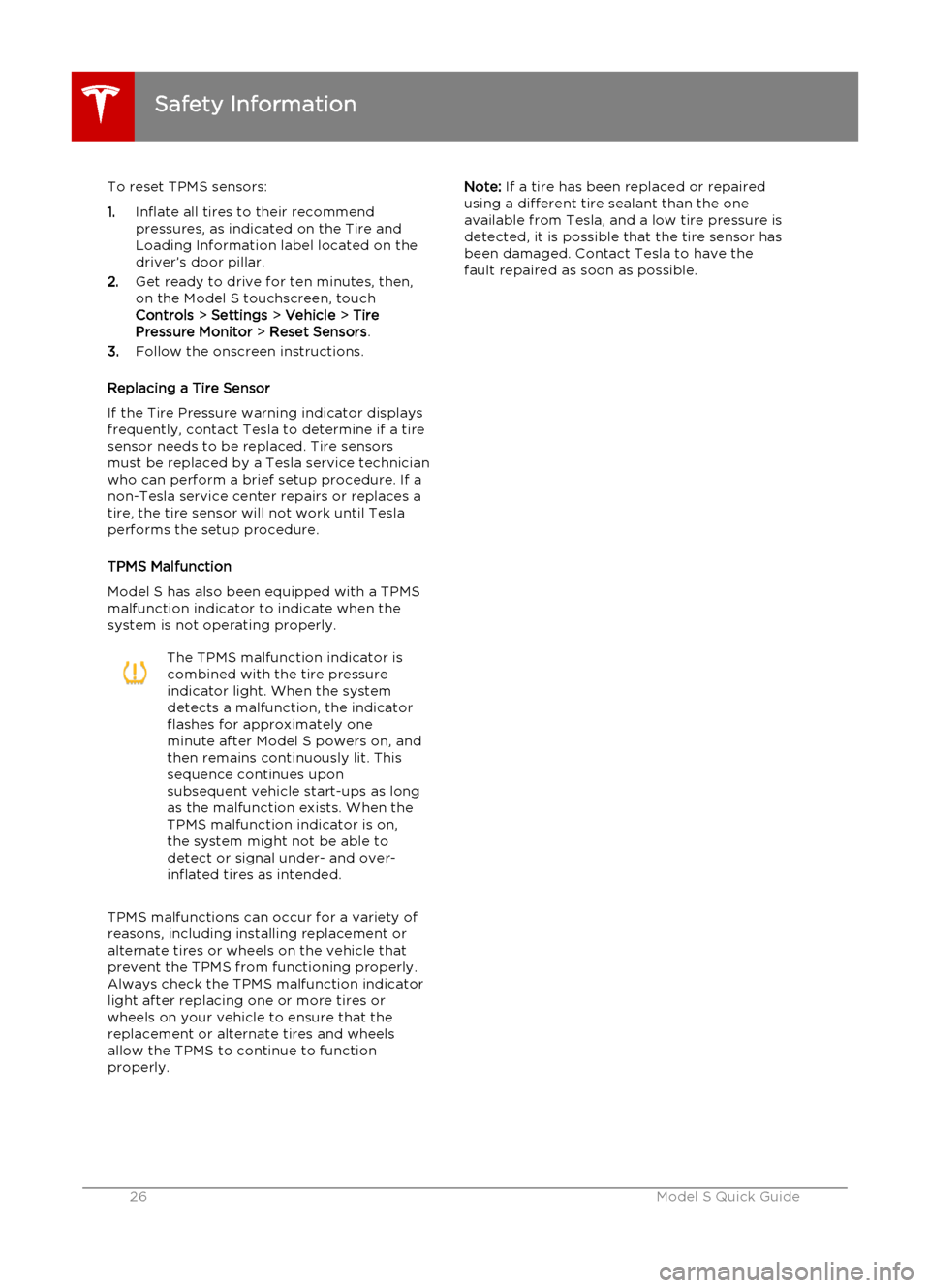
To reset TPMS sensors:
1. Inflate all tires to their recommend
pressures, as indicated on the Tire and
Loading Information label located on the
driver’s door pillar.
2. Get ready to drive for ten minutes, then,
on the Model S touchscreen, touch
Controls > Settings > Vehicle > Tire
Pressure Monitor > Reset Sensors .
3. Follow the onscreen instructions.
Replacing a Tire Sensor
If the Tire Pressure warning indicator displays
frequently, contact Tesla to determine if a tire
sensor needs to be replaced. Tire sensors
must be replaced by a Tesla service technician
who can perform a brief setup procedure. If a
non-Tesla service center repairs or replaces a
tire, the tire sensor will not work until Tesla
performs the setup procedure.
TPMS Malfunction
Model S has also been equipped with a TPMS
malfunction indicator to indicate when the
system is not operating properly.The TPMS malfunction indicator is
combined with the tire pressure
indicator light. When the system
detects a malfunction, the indicator
flashes for approximately one
minute after Model S powers on, and
then remains continuously lit. This
sequence continues upon
subsequent vehicle start-ups as long
as the malfunction exists. When the
TPMS malfunction indicator is on,
the system might not be able to
detect or signal under- and over-
inflated tires as intended.
TPMS malfunctions can occur for a variety of
reasons, including installing replacement oralternate tires or wheels on the vehicle thatprevent the TPMS from functioning properly.Always check the TPMS malfunction indicator
light after replacing one or more tires or
wheels on your vehicle to ensure that the replacement or alternate tires and wheels
allow the TPMS to continue to function
properly.
Note: If a tire has been replaced or repaired
using a different tire sealant than the one
available from Tesla, and a low tire pressure is
detected, it is possible that the tire sensor has
been damaged. Contact Tesla to have the
fault repaired as soon as possible.
Safety Information
26Model S Quick Guide
Page 37 of 96
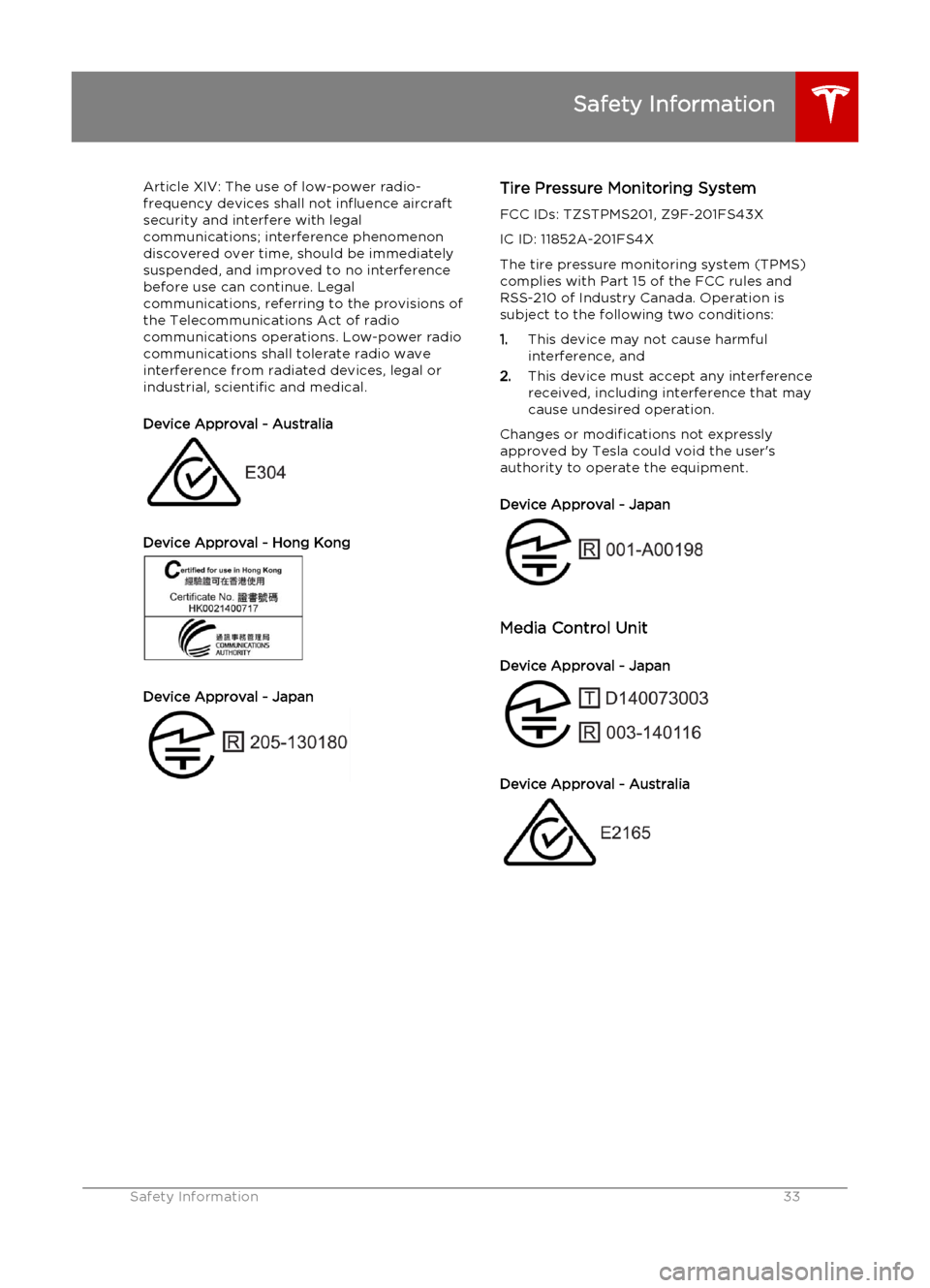
Article XIV: The use of low-power radio-
frequency devices shall not influence aircraft security and interfere with legal
communications; interference phenomenon
discovered over time, should be immediately suspended, and improved to no interference
before use can continue. Legal
communications, referring to the provisions of
the Telecommunications Act of radio communications operations. Low-power radiocommunications shall tolerate radio wave
interference from radiated devices, legal or
industrial, scientific and medical.
Device Approval - Australia
Device Approval - Hong Kong
Device Approval - Japan
Tire Pressure Monitoring System
FCC IDs: TZSTPMS201, Z9F-201FS43X IC ID: 11852A-201FS4X
The tire pressure monitoring system (TPMS)
complies with Part 15 of the FCC rules and
RSS-210 of Industry Canada. Operation is subject to the following two conditions:
1. This device may not cause harmful
interference, and
2. This device must accept any interference
received, including interference that may
cause undesired operation.
Changes or modifications not expressly
approved by Tesla could void the user's authority to operate the equipment.
Device Approval - Japan
Media Control Unit
Device Approval - Japan
Device Approval - Australia
Safety Information
Safety Information33
Page 48 of 96

T
telematics 31
tie-down straps 4
Tire and Loading Information label 29Tire Pressure Monitoring SystemFCC certification 33
overview of 25
tire pressures, checking 22
tiresbalancing 23
chains 25
inspecting and maintaining 23
pressures, how to check 22
replacing 24
replacing a tire sensor 26
rotation 23
tire markings 27
winter 24
tow chain, connecting 4
Tow mode 3
towing 3
towing a trailer 30
towing instructions 3
TPMSFCC certification 33
overview of 25
trailer hitches 30
transporting 3
V
vehicle loading 29
W wheel chocks 4
wheelsalignment 23
replacing 24
winter tires 24
Index
44Model S Quick Guide
Page 72 of 96
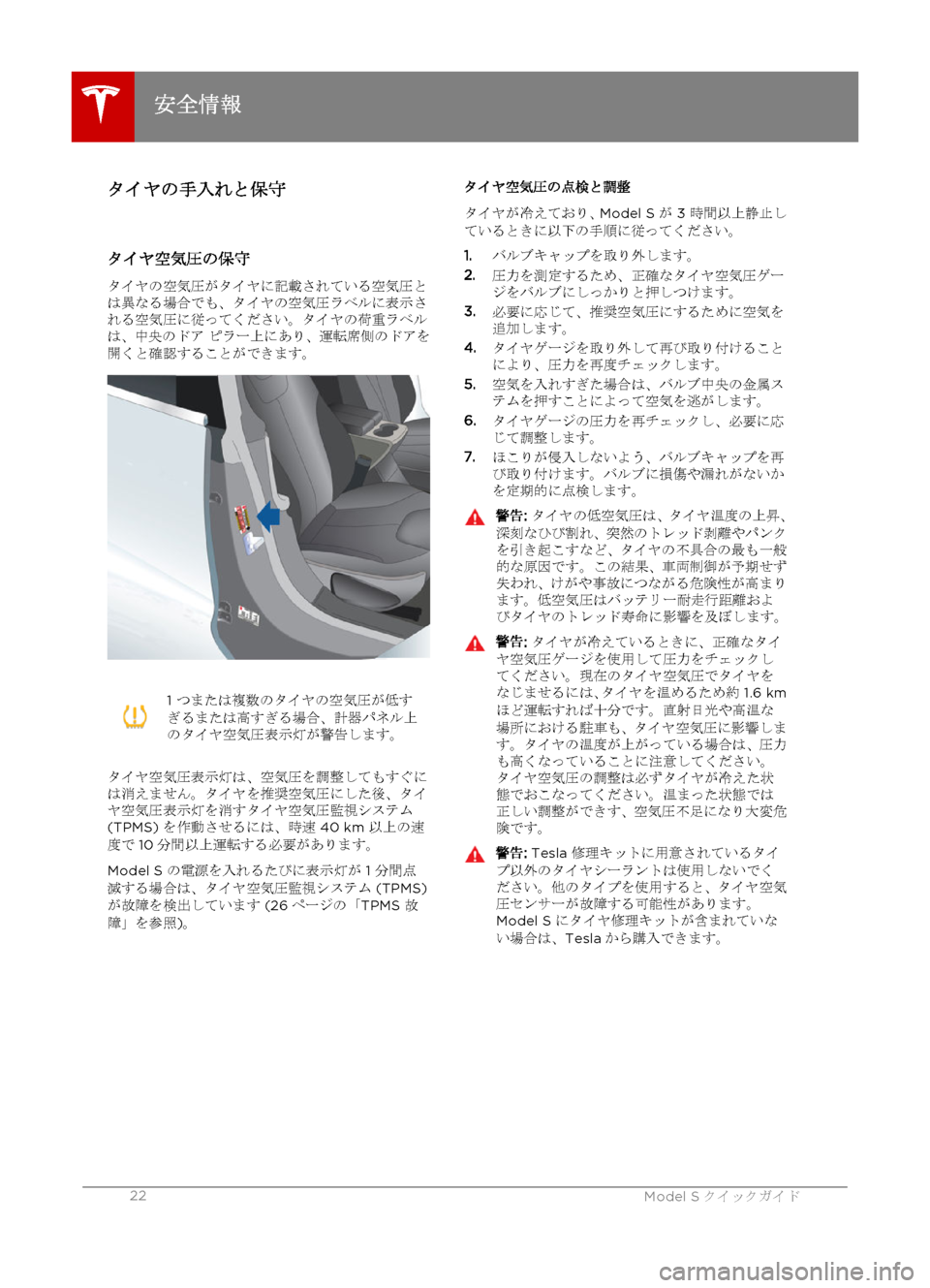
タイヤの手入れと保守
タイヤ空気圧の保守
タイヤの空気圧がタイヤに記載されている空気圧と
は異なる場合でも、タイヤの空気圧ラベルに表示さ
れる空気圧に従ってください。タイヤの荷重ラベル
は、中央のドア ピラー上にあり、運転席側のドアを
開くと確認することができます。1 つまたは複数のタイヤの空気圧が低す
ぎるまたは高すぎる場合、計器パネル上
のタイヤ空気圧表示灯が警告します。
タイヤ空気圧表示灯は、空気圧を調整してもすぐに
は消えません。タイヤを推奨空気圧にした後、タイ
ヤ空気圧表示灯を消すタイヤ空気圧監視システム
(TPMS) を作動させるには、時速 40 km 以上の速
度で 10分間以上運転する必要があります。
Model S の電源を入れるたびに表示灯が 1 分間点
滅する場合は、タイヤ空気圧監視システム (TPMS)
が故障を検出しています (26ページの「 TPMS 故
障」を参照 )。
タイヤ空気圧の点検と調整
タイヤが冷えており、 Model S が 3 時間以上静止し
ているときに以下の手順に従ってください。
1. バルブキャップを取り外します。
2. 圧力を測定するため、正確なタイヤ空気圧ゲー
ジをバルブにしっかりと押しつけます。
3. 必要に応じて、推奨空気圧にするために空気を
追加します。
4. タイヤゲージを取り外して再び取り付けること
により、圧力を再度チェックします。
5. 空気を入れすぎた場合は、バルブ中央の金属ス
テムを押すことによって空気を逃がします。
6. タイヤゲージの圧力を再チェックし、必要に応
じて調整します。
7. ほこりが侵入しないよう、バルブキャップを再
び取り付けます。バルブに損傷や漏れがないか
を定期的に点検します。警告 : タイヤの低空気圧は、タイヤ温度の上昇、
深刻なひび割れ、突然のトレッド剥離やパンク を引き起こすなど、タイヤの不具合の最も一般
的な原因です。この結果、車両制御が予期せず 失われ、けがや事故につながる危険性が高まり
ます。低空気圧はバッテリー耐走行距離およ びタイヤのトレッド寿命に影響を及ぼします。警告 : タイヤが冷えているときに、正確なタイ
ヤ空気圧ゲージを使用して圧力をチェックし
てください。現在のタイヤ空気圧でタイヤを
なじませるには、タイヤを温めるため約 1.6 km
ほど運転すれば十分です。直射日光や高温な 場所における駐車も、タイヤ空気圧に影響します。タイヤの温度が上がっている場合は、圧力も高くなっていることに注意してください。
タイヤ空気圧の調整は必ずタイヤが冷えた状
態でおこなってください。温まった状態では
正しい調整ができす、空気圧不足になり大変危
険です。警告 : Tesla 修理キットに用意されているタイ
プ以外のタイヤシーラントは使用しないでく
ださい。他のタイプを使用すると、タイヤ空気 圧センサーが故障する可能性があります。
Model S にタイヤ修理キットが含まれていな
い場合は、 Teslaから購入できます。
安全情報
22Model S クイックガイド
Page 74 of 96
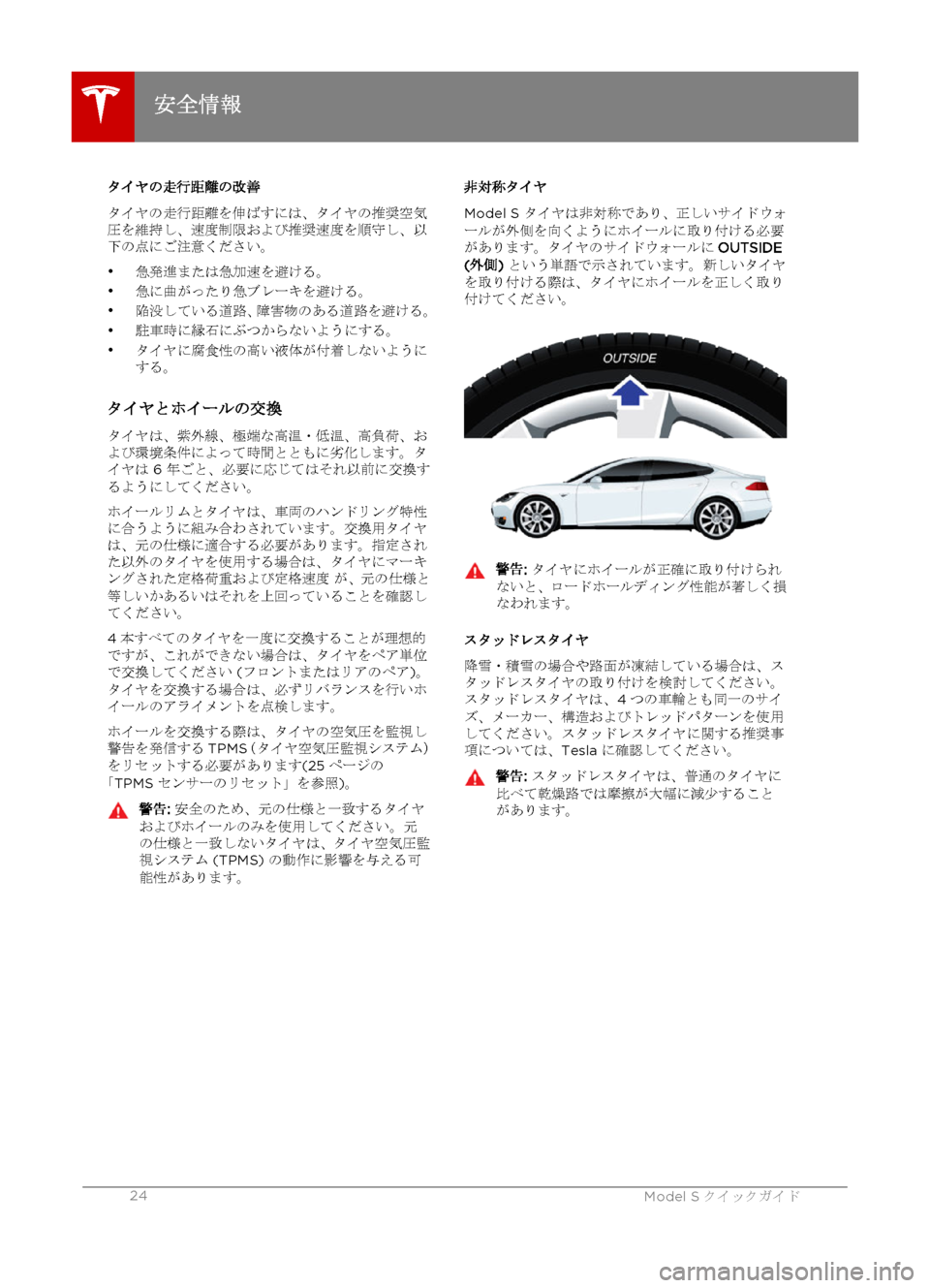
タイヤの走行距離の改善
タイヤの走行距離を伸ばすには、タイヤの推奨空気
圧を維持し、速度制限および推奨速度を順守し、以
下の点にご注意ください。
• 急発進または急加速を避ける。
• 急に曲がったり急ブレーキを避ける。
• 陥没している道路、障害物のある道路を避ける。
• 駐車時に縁石にぶつからないようにする。
• タイヤに腐食性の高い液体が付着しないように
する。
タイヤとホイールの交換 タイヤは、紫外線、極端な高温・低温、高負荷、お
よび環境条件によって時間とともに劣化します。タ
イヤは 6 年ごと、必要に応じてはそれ以前に交換す
るようにしてください。
ホイールリムとタイヤは、車両のハンドリング特性
に合うように組み合わされています。交換用タイヤ
は、元の仕様に適合する必要があります。指定され
た以外のタイヤを使用する場合は、タイヤにマーキ
ングされた定格荷重および定格速度 が、元の仕様と
等しいかあるいはそれを上回っていることを確認し
てください。
4 本すべてのタイヤを一度に交換することが理想的
ですが、これができない場合は、タイヤをペア単位
で交換してください (フロントまたはリアのペア )。
タイヤを交換する場合は、必ずリバランスを行いホ
イールのアライメントを点検します。
ホイールを交換する際は、タイヤの空気圧を監視し
警告を発信する TPMS(タイヤ空気圧監視システム)
をリセットする必要があります (25ページの
「 TPMS センサーのリセット」を参照 )。警告 :
安全のため、元の仕様と一致するタイヤ
およびホイールのみを使用してください。元
の仕様と一致しないタイヤは、タイヤ空気圧監 視システム (TPMS) の動作に影響を与える可
能性があります。非対称タイヤ
Model S タイヤは非対称であり、正しいサイドウォ
ールが外側を向くようにホイールに取り付ける必要 があります。タイヤのサイドウォールに OUTSIDE
( 外側 ) という単語で示されています。新しいタイヤ
を取り付ける際は、タイヤにホイールを正しく取り 付けてください。警告 : タイヤにホイールが正確に取り付けられ
ないと、ロードホールディング性能が著しく損 なわれます。
スタッドレスタイヤ
降雪・積雪の場合や路面が凍結している場合は、ス
タッドレスタイヤの取り付けを検討してください。
スタッドレスタイヤは、 4つの車輪とも同一のサイ
ズ、メーカー、構造およびトレッドパターンを使用
してください。スタッドレスタイヤに関する推奨事
項については、 Tesla に確認してください。
警告:
スタッドレスタイヤは、普通のタイヤに
比べて乾燥路では摩擦が大幅に減少すること
があります。
安全情報
24Model S クイックガイド
Page 75 of 96
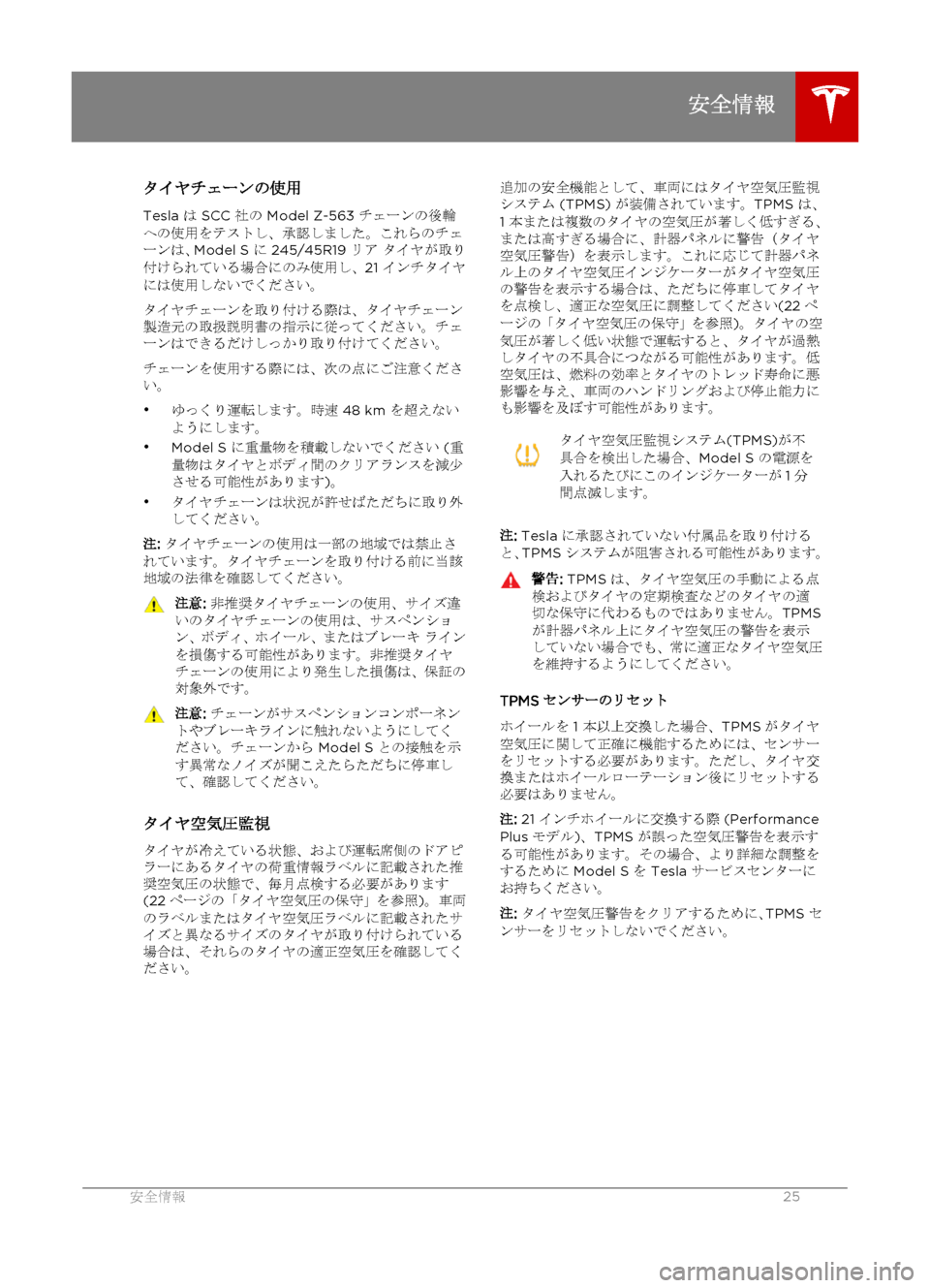
タイヤチェーンの使用
Tesla は SCC 社の Model Z-563 チェーンの後輪
への使用をテストし、承認しました。これらのチェ ーンは、 Model S に 245/45R19 リア タイヤが取り
付けられている場合にのみ使用し、 21 インチタイヤ
には使用しないでください。
タイヤチェーンを取り付ける際は、タイヤチェーン 製造元の取扱説明書の指示に従ってください。チェ
ーンはできるだけしっかり取り付けてください。
チェーンを使用する際には、次の点にご注意くださ
い。
• ゆっくり運転します。時速 48 km を超えない
ようにします。
• Model S に重量物を積載しないでください (重
量物はタイヤとボディ間のクリアランスを減少
させる可能性があります )。
• タイヤチェーンは状況が許せばただちに取り外
してください。
注 : タイヤチェーンの使用は一部の地域では禁止さ
れています。タイヤチェーンを取り付ける前に当該
地域の法律を確認してください。注意 : 非推奨タイヤチェーンの使用、サイズ違
いのタイヤチェーンの使用は、サスペンショ
ン、ボディ、ホイール、またはブレーキ ライン
を損傷する可能性があります。非推奨タイヤ チェーンの使用により発生した損傷は、保証の
対象外です。注意 : チェーンがサスペンションコンポーネン
トやブレーキラインに触れないようにしてく
ださい。チェーンから Model S との接触を示
す異常なノイズが聞こえたらただちに停車し
て、確認してください。
タイヤ空気圧監視
タイヤが冷えている状態、および運転席側のドアピ
ラーにあるタイヤの荷重情報ラベルに記載された推 奨空気圧の状態で、毎月点検する必要があります(22 ページの「タイヤ空気圧の保守」を参照 )。車両
のラベルまたはタイヤ空気圧ラベルに記載されたサ
イズと異なるサイズのタイヤが取り付けられている
場合は、それらのタイヤの適正空気圧を確認してく ださい。
追加の安全機能として、車両にはタイヤ空気圧監視
システム (TPMS) が装備されています。 TPMS は、
1 本または複数のタイヤの空気圧が著しく低すぎる、
または高すぎる場合に、計器パネルに警告(タイヤ
空気圧警告)を表示します。これに応じて計器パネ
ル上のタイヤ空気圧インジケーターがタイヤ空気圧
の警告を表示する場合は、ただちに停車してタイヤ
を点検し、適正な空気圧に調整してください (22ペ
ージの「タイヤ空気圧の保守」を参照 )。タイヤの空
気圧が著しく低い状態で運転すると、タイヤが過熱
しタイヤの不具合につながる可能性があります。低
空気圧は、燃料の効率とタイヤのトレッド寿命に悪
影響を与え、車両のハンドリングおよび停止能力に
も影響を及ぼす可能性があります。タイヤ空気圧監視システム (TPMS)が不
具合を検出した場合、 Model S の電源を
入れるたびにこのインジケーターが 1分
間点滅します。
注 : Tesla に承認されていない付属品を取り付ける
と、 TPMS システムが阻害される可能性があります。
警告: TPMS は、タイヤ空気圧の手動による点
検およびタイヤの定期検査などのタイヤの適
切な保守に代わるものではありません。 TPMS
が計器パネル上にタイヤ空気圧の警告を表示
していない場合でも、常に適正なタイヤ空気圧 を維持するようにしてください。
TPMS センサーのリセット
ホイールを 1 本以上交換した場合、 TPMSがタイヤ
空気圧に関して正確に機能するためには、センサー
をリセットする必要があります。ただし、タイヤ交
換またはホイールローテーション後にリセットする 必要はありません。
注 : 21 インチホイールに交換する際 (Performance
Plus モデル )、 TPMS が誤った空気圧警告を表示す
る可能性があります。その場合、より詳細な調整を
するために Model S を Tesla サービスセンターに
お持ちください。
注 : タイヤ空気圧警告をクリアするために、 TPMS セ
ンサーをリセットしないでください。
安全情報
安全情報25
Page 76 of 96
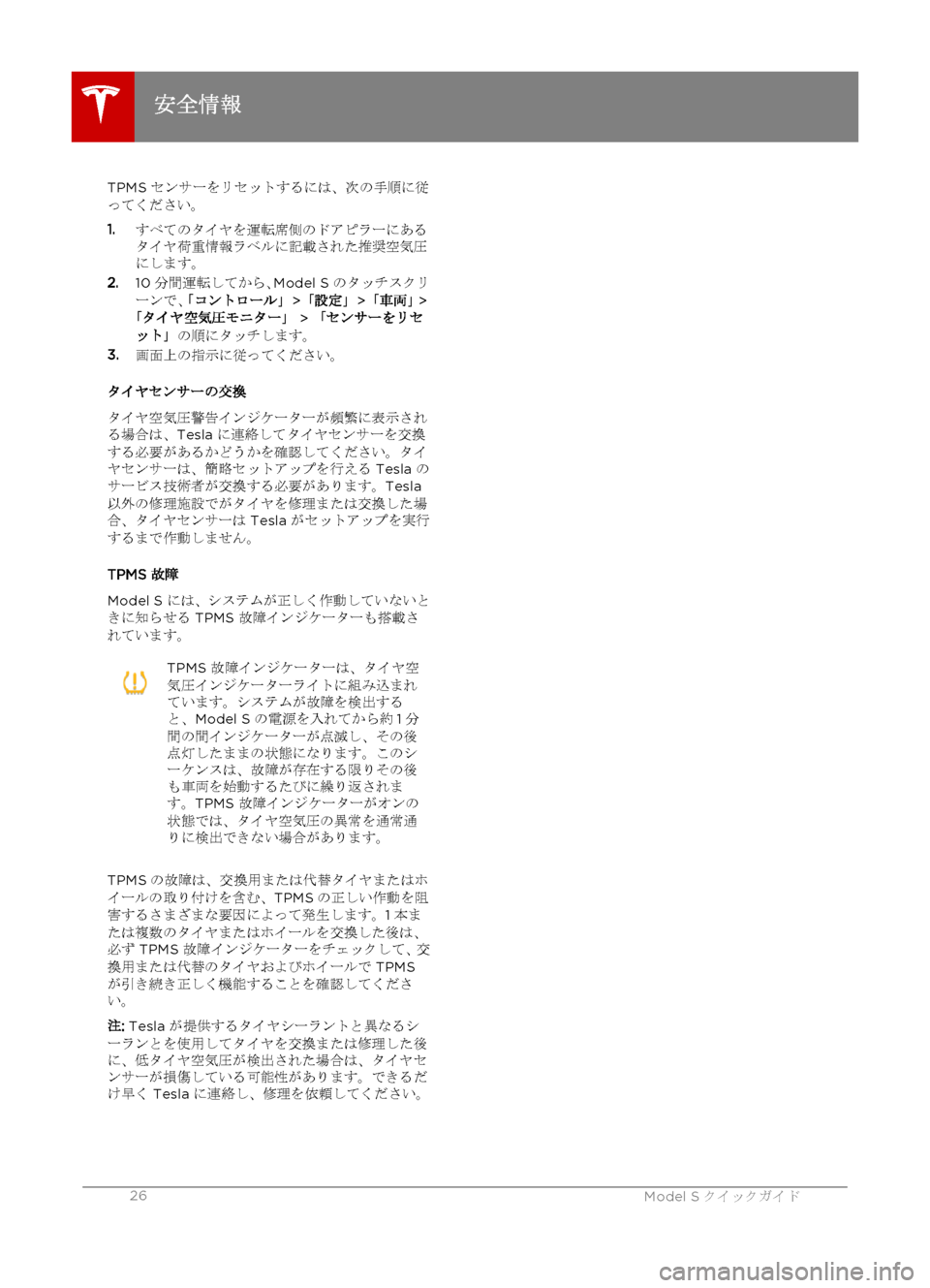
TPMS センサーをリセットするには、次の手順に従
ってください。
1. すべてのタイヤを運転席側のドアピラーにある
タイヤ荷重情報ラベルに記載された推奨空気圧
にします。
2. 10 分間運転してから、 Model S のタッチスクリ
ーンで、 「コントロール」 > 「設定」 > 「車両」 >
「タイヤ空気圧モニター」 > 「センサーをリセ
ット」 の順にタッチします。
3. 画面上の指示に従ってください。
タイヤセンサーの交換
タイヤ空気圧警告インジケーターが頻繁に表示され
る場合は、 Tesla に連絡してタイヤセンサーを交換
する必要があるかどうかを確認してください。タイ ヤセンサーは、簡略セットアップを行える Tesla の
サービス技術者が交換する必要があります。 Tesla
以外の修理施設でがタイヤを修理または交換した場
合、タイヤセンサーは Tesla がセットアップを実行
するまで作動しません。
TPMS 故障
Model S には、システムが正しく作動していないと
きに知らせる TPMS 故障インジケーターも搭載さ
れています。TPMS 故障インジケーターは、タイヤ空
気圧インジケーターライトに組み込まれ
ています。システムが故障を検出する
と、 Model S の電源を入れてから約 1分
間の間インジケーターが点滅し、その後
点灯したままの状態になります。このシ
ーケンスは、故障が存在する限りその後
も車両を始動するたびに繰り返されま
す。 TPMS 故障インジケーターがオンの
状態では、タイヤ空気圧の異常を通常通
りに検出できない場合があります。
TPMS の故障は、交換用または代替タイヤまたはホ
イールの取り付けを含む、 TPMSの正しい作動を阻
害するさまざまな要因によって発生します。 1本ま
たは複数のタイヤまたはホイールを交換した後は、 必ず TPMS 故障インジケーターをチェックして、交
換用または代替のタイヤおよびホイールで TPMS
が引き続き正しく機能することを確認してくださ
い。
注 : Tesla が提供するタイヤシーラントと異なるシ
ーランとを使用してタイヤを交換または修理した後
に、低タイヤ空気圧が検出された場合は、タイヤセ ンサーが損傷している可能性があります。できるだ
け早く Tesla に連絡し、修理を依頼してください。
安全情報
26Model S クイックガイド